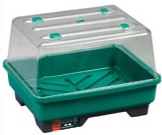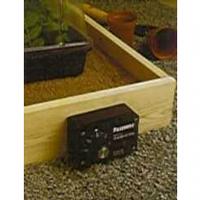Categories
Calendars
Guides
Reviews
Archive
Gallery
Articles
Ask Our Gardening Expert
TOPICS IN SELECTING EQUIPMENT FOR
YOUR GARDEN GREENHOUSE
Why Warm Your Soil?
For this reason, the use of
soil warming equipment is both productive and economical in a greenhouse.
It will allow your plants to get off to an early start and will maintain
even temperatures which help to avoid and checks to growth.
The use of soil warming equipment is frequently used by amateur
gardeners attempting to grow prize-winning huge vegetables. If they use
it, you can be sure it is of great use. There are two main methods of warming the soil in your greenhouse. The
first, rarely used because of the complexity and expense is water pipes
laid under the soil which have pumps to circulate warm water round them.
This is not a method we would advise for most gardeners. The application of heat to soil makes very little difference to the
surrounding air temperature but it does allow the greenhouse to kept at a
lower temperature with no adverse affect on your plants. This really does
reduce considerably the cost of using a greenhouse in the colder months. Ready made units are
widely available which incorporate cables and a built in
thermostat, some also have a clear perspex cover to retain heat
but allow light to reach the plants. Our recommended supplier for
propagating kits is Harrod Horticultural. They produce top quality
equipment at good prices. Click here to view some of their
products. It is also entirely possible to build
your own propagator to fit the exact space available to you. If you wish
to do this follow the instructions below. Buy good quality equipment and
be sure to follow all the manufacturers instructions - electricity and
moist soil only go together when the correct procedures are followed and
good equipment is used. Put a piece of 1" polystyrene covered polythene in the
base, lay the soil warming cables on it and cover with approx: 1.5"
(3/4cm)of coarse sand. The cables will need to be connected to the
electric supply as recommended by the manufacturer. The pots or trays are
then simply placed on the sand which will warm them. To get the best use out of this equipment, connect up a thermostat to
the soil warming electric cables as per the instructions and you will
have the perfect environment for your plants in the greenhouse. Click
here if you wish to buy soil warming cables online from our
recommended suppliers.
Plants react adversely when either the air or soil temperature drops
below certain levels. However, with a warm soil plants will be much more
capable of standing low air temperatures. SOIL WARMING CABLES - COMMON METHODS
 A much more common method of soil warming is the use of
plastic propagating trays which have soil warming cables in their base
connected to the standard electricity supply. Normally a thermostat is
also built-in to enable the temperature to be varied at will and kept
constant.
A much more common method of soil warming is the use of
plastic propagating trays which have soil warming cables in their base
connected to the standard electricity supply. Normally a thermostat is
also built-in to enable the temperature to be varied at will and kept
constant. SOIL WARMING CABLES - BUILD YOUR OWN UNIT
 Make a wooden frame
with sides which are about 4" (10cm) high with a base
(like a drawer). You may wish to protect the wood from water damage by
covering the base and inner sides with plastic sheeting.
Make a wooden frame
with sides which are about 4" (10cm) high with a base
(like a drawer). You may wish to protect the wood from water damage by
covering the base and inner sides with plastic sheeting.
